History and Traditions of the Pandharpur Vithoba Temple
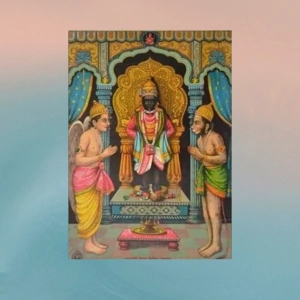
‘Blessed are the fortunate people of Pandhari who enjoy the happiness that the love of Vithoba brings’ - Bahinabai.
Why is Pandharpur famous?
Pandharpur is famous for being one of the most important Hindu pilgrimage sites in India. Pandharpur is home to the famous Vithoba Temple, dedicated to Lord Krishna and his consort Rukmini. Every year, hundreds of thousands of pilgrims from all over India make a spiritual journey to this sacred site in order to offer prayers and get blessings.
What is the meaning of Vitthal?
Vitthal is derived from two Marathi words, ‘vit’ and ‘thal’. ‘Vit’ means brick. ‘thal’ is equivalent to ‘sthala’ in Sanskrit which means place. ‘Vitthal’ means ‘one who stands on a brick’. A Varkari aspires to become that brick upon which Vitthal stands. Jnanadeva says, ‘I shall become this solid brick under the feet of Vithoba’. Nivrittidas says, ‘I put myself under the feet of Vithoba, I shall not become a brick anywhere else.’ It is also considered as a combination of three words, ‘vi’, ‘tha’, and ‘la’. It means ‘one who takes into his fold those devoid of knowledge’.
What is the meaning of Vithoba?
Sant Tukaram in an abhang says, ‘Vithoba is the storehouse of all knowledge, that’s why he is called Vithoba’. ‘Vi’ in Vithoba means knowledge and ‘thoba’ means a storehouse.
What is the story of Pandharpur?
The famous Bhakt Pundalik used to be King Muchkund in the DwaparaYuga who had helped the Devas in a battle against Asuras. Grateful for his aid, they offered him any boon he wanted and he asked for the power to burn anyone to ashes with a single glance if they disturbed his sleep. Years later, during Shri Krishna's incarnation an Asura called Kalayavana attacked Krishna, Krishna took Kalayavana to King Muchkunda's cave and threw his cloak on the sleeping king. The Asura thought Muchkunda was actually Krishna and attacked him. Furious at being disturbed, Muchkinda looked upon Kalayavana with his powerful gaze, burning him to ashes right then and there. Shri Krishna granted Muchkunda his wish of keeping this special power through many lifetimes until he finally incarnated as Bhakt Pundalik and settled near Pandharpur.
As per another legend, Rukmini, wife of Shri Krishna, was deeply saddened when she found out that he was closer to Radha. She went to Dindir Van where she started meditating in search of solace. When Krishna came to Pandharpur, she reunited with him.
Pundalik and Pandharpur
Pundalik is considered the very first Varkari.
His mystical experiences were centered around the divine figure of Vitthala.
He transformed traditional ritualistic worship into an internalized adoration of the Lord.
Caste discrimination and institutionalized priesthood had no place in his system.
He was also influenced by the HaridasaPanth of Karnataka.
Pundalik became so famous that Pandharpur came to be called PaundarikaKshetra.
History of Pandharpur temple
According to an inscription found in Pandharpur, the temple was erected as a small structure in the year 1189 CE.
At that time, Yadava king Bhillamma financed this construction.
Pandharpur became the battlefield between the Yadava kingdom and the Hoysala kingdom.
In 1189, it was under the Yadavas.
Then in 1237, it came under Hoysala rule.
In 1273, it went back to the Yadavas.
According to inscriptions found in Shimoga, Hassan, and Kadur dating back to 618 CE, the place was called ‘Pandaraga Vittaga’ which later got modified into Panduranga Vitthala.
An inscription calling Vithoba ‘Panduranga Vitthala’ dates back to 1270 CE.
By 1237 CE., Pandharpur also became famous as the place of Pundalik (Pundarika Muni).
This is where Pundalik took samadhi.
Namdev was born at Pandharpur around 1270 CE.
His works talk about Pundalik.
In 516 CE., Pandharpur was a small village.
It was donated to Jayadvittha.
It is believed that the villagers worshiped Vithoba for the welfare of their cattle.
By the 12th century CE., many temples dedicated to Vitthala were built at different places, particularly on the banks of Tungabhadra.
An extensive temple was constructed in the second half of the thirteenth century following the Hemadpanti style of architecture.
Only the Namdev-gate and a stone slab with an inscription remain from that structure.
The temple was attacked by invaders and completely damaged.
It is believed that the idol was taken to Vijaynagar towards the end of the fifteenth century and brought back at the beginning of the sixteenth century.
The present temple was built in the sixteenth century.
It was in the year 1958 CE that Badvas, the traditional administrators, threw open the temple to all irrespective of caste or creed.
Worship of Vithoba
The ritualistic worship of Vithoba at Pandharpur temple is carried out by a Brahmin community called the Badvas.
There are seven roles of priests in the worship -
- Pujari - bathing of the idol, dressing, putting garlands, aarti, and offering dhupa.
- Benari - chanting of mantras.
- Paricharaka - providing water, preparing dhupa and aarti, and distributing holy ashes to the devotees.
- Haridasa - sings songs in Marathi during aartis.
- Dingre - showing a mirror to the Lord and spreading a carpet between the idol and bedroom.
- Divate - holding a torch when Vithoba goes to the sleeping chamber and when his padukas are taken out during Ashadi and Karthik Purnimas.
- Dange - holding of a mace during ceremonies.
Daily Pujas
Kakadarati
Kakada is the name of the coarse wick used for this aarti.
Kakadarati starts at 3 a.m.
A trumpet called Karna is blown.
All priests and attendants assemble.
The Badva comes with the key, stands in front of the garbhagriha, and prays to the Lord to wake up.
Then the door is opened.
All priests except Haridasa are allowed to enter the garbhagriha.
Food offerings placed on the previous night in the bed-chamber are removed.
The Pujari washes the feet of the idol with milk and water.
All the garlands and flowers from the previous day are removed.
Fresh garlands are put.
Dhoop, lamp, and naivedya are offered.
Kakadarati is performed.
During this time, Haridasa sings hymns from outside.
After the aarti, fresh butter and sugar are offered to the Lord.
Then, niranjan is performed.
Devotees offer flowers.
Tirtha and flowers from the previous day are given as prasada.
Panchamrita Puja
The idol is bathed first with water followed by milk, curd, ghee, honey, and sugar.
Then it is bathed with water again, water is poured over the head with a shankha, and then again bathed with scented oil and warm water.
The Benari chants Veda mantras during this time.
The idol is wiped, adorned with fresh clothes, sandal powder and scented oil are applied to the face, a turban is tied around the mukuta, sandalwood paste is applied to the forehead, and garlands put around the neck.
Then dhoop, lamp, and sweets are offered.
After this, devotees can enter for darshan.
Madhyahna Puja
Old garments and garlands are removed.
The face is washed and sandal paste is applied to the brows.
Fresh garments are put on.
Mahanaivedya is offered.
Aparahnapuja
Performed at sunset.
The Pujari washes the feet of the idol.
Fresh sandal paste is applied.
Old garlands are removed and new garlands put on.
Aarti is performed.
Naivedya is offered.
Ashes from the lamps are applied as tilak on the foreheads of the devotees.
Sejarti
It is the ritual of putting the Lord to sleep.
It is done around 10 p.m.
The bedroom is opened and the bed is prepared.
A lamp, milk, sweets, and a spittoon are kept near the bed.
The path between the idol and the bedroom is cleaned, sprinkled with water, and rangoli is drawn.
A carpet is spread between the idol and the bedroom.
The Dange and Divate stand on either side of the carpet.
The Dingre and Benari stand near the idol.
Benari chants mantras.
The Pujari washes the Lord’s feet.
Then he changes the Lord’s garments and applies fresh sandal paste.
Fresh garlands are put and sweets are offered.
The Bavda performs the final aarti, everyone leaves, and the door is closed.
Which form of Krishna is Vithoba?
Vithoba is Krishna’s GopalaKrishna form. It represents how the Lord came to Pandharpur from Dwaraka along with his cows. This is evident from the following facts -
- At Vishnupada, the footprints of cows are also worshiped along with the footprints of Krishna.
- During Sejarati, a carpet is placed between the idol and the bedroom of the Lord. On this carpet, there are footprints of both Krishna and a cow.
- On the back of the idol, there are marks left by a bag in which Krishna used to carry his food while grazing his cows.
- The food offered in the name Namdev (kala) is a traditional pastoral food.
Features of Vithoba’s idol
- Standing in the SamaPadaStanaka posture.
- The legs are straight and parallel.
- Both arms are placed on the hips in the akimbo position.
- The left-hand holds a shankha and the right-hand holds a kambal.
- The feet are at the same level and rest on a small platform called the brick.
- The mukuta is high and cylindrical in shape.
- The Lord wears a loincloth.
Pilgrimage to Pandharpur
Annual pilgrimage to Pandharpur is an integral part of a Varkari’s life.
They must go there at least twice a year, on Ashadi Ekadashi and Karthik Ekadashi.
Another important day is Chaitri Ekadashi.
Ashadi Ekadashi is a group activity and the entire VarkariPanth assembles at Pandharpur on that day.
The pilgrims should walk all the way to Pandharpur.
In the earlier days, Santas used to undertake these pilgrimages along with their disciples.
For those on the way, these Santas were walking Gods.
Getting their darshan was like getting the darshan of Vithoba himself.
The pilgrims are respected everywhere.
They are provided food and a place to rest by villages on the way.
Each procession of Pandharpur pilgrims is called a Palkhi.
The Palkhis carry a palanquin with a pair of padukas of a Santa.
The palanquin itself is placed on a cart.
The most important of the Palkhis is the Palkhi of Jnaneswar starting from Alandi.
The procession is divided into smaller groups called Dindis.
Each Dindi has a leader carrying a Vina (string instrument).
He represents Sant Tukaram.
There is also a drummer in every Dindi.
All the men carry cymbals and the singing of abhangs goes on continuously as long as the Palkhi is on the road.
All pilgrims wear a rosary of Tulsi.
Some women carry pots of Tulsi on their heads.
Many carry flags.
More and more pilgrims join the procession on the way as it proceeds.
On the Navami, all Palkhis reach Wakhri village.
The next day, they proceed towards Pandharpur and reach there at night.
Everyone takes darshan of Vithoba on Ashadi Ekadashi and that is the culmination of the pilgrimage.
Vithoba Temple
The temple of Vithoba is on top of a small hillock.
It is surrounded by houses and small lanes.
A street called Pradakshina Road surrounds the base of the hillock.
From each cardinal direction, a lane starts from Pradakshina Road and goes up to the temple.
These lanes are considered very holy.
Every time someone crosses it, he has to do atma-pradakshina.
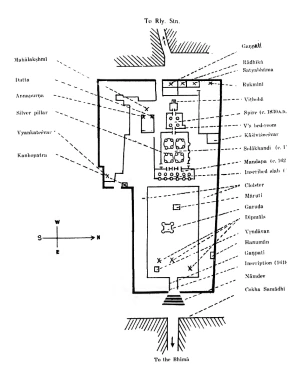 The main entrance to the temple is in the east and it faces the river.
The main entrance to the temple is in the east and it faces the river.
The temple complex houses many buildings of various shapes, sizes, and ages.
They have been built over a period of time catering to the needs of the devotees.
Frequently Asked Questions
What is the significance of the brick upon which Vitthal is standing?
Indra killed Vritrasura. While dying Vritrasura cursed Indra to become a brick.
It was on this brick that Vitthala stood when he came to visit Pundalik. As a result of the touch of the Lord’s feet, Indra got back his original body.
Which God is in Pandharpur temple?
The temple at Pandharpur is dedicated to Lord Vitthala, an avatar of Vishnu. The form of Lord Vitthala worshiped here is often called Vithoba or Panduranga, and he is accompanied by his consort Rukmini.
Why does Vitthal have fish in ears?
The ears of Lord Vitthal are in the shape of fish because it was believed that when devotees speak about their problems, Lord Vitthal “listens” with his fish-shaped ears and walks on water to reach out to them. This belief served as an inspiration for many devotees.
Which day of the week is for Lord Vitthal?
Wednesdays are particularly sacred for the worship of Lord Vitthal.
What are the benefits of chanting Vitthal?
Chanting the name of Vitthal brings a person closer to salvation and enlightenment. Additionally, it brings peace, joy, and serenity to one’s mind, removes negative energy from life, increases patience and concentration levels, cleanses the soul, and removes all impurities from the heart.
Why did Krishna come to Pandharpur?
Sant Pundalik lived in Pandharpur. His devotion to the service of his old parents was extraordinary. Lord Krishna was so impressed with him that he came to Pandharpur along with nine lakhs of cows and a hundred companions to witness the devotion of Pundalik.
What was Vithoba called in Kannada?
Bittaga. By 848 CE.Bittaga had become synonymous with Vishnu in Kannada.
Which is the closest airport to Pandharpur?
Pune at a distance of 180 km.
How to reach Pandharpur from Mumbai?
- Overnight Train - 9 hrs.
- Direct bus - 8 hrs 30 mins.
- Drive - 360 km
How to reach Pandharpur from Pune?
- Bus - 3 hrs 45 mins
- Train - 5 hrs 10 mins
- Drive - 210 km
How to reach Pandharpur from Solapur?
- Bus - 1 hr.
- Drive - 70 km.
How to reach Pandharpur from Nagpur?
- Train - 18 hrs 30 mins
- Drive - 640 km
- Fly to Pune, Then
- Bus - 3 hrs 45 mins
- Train - 5 hrs 10 mins
- Drive - 210 km
How to reach Pandharpur from Shirdi?
- Train - 7 hrs 30 mins
- Drive/Taxi - 4 hrs
How to reach Pandharpur from Kurduvadi?
- Train - 40 min
- Drive/Taxi - 52 km
Location
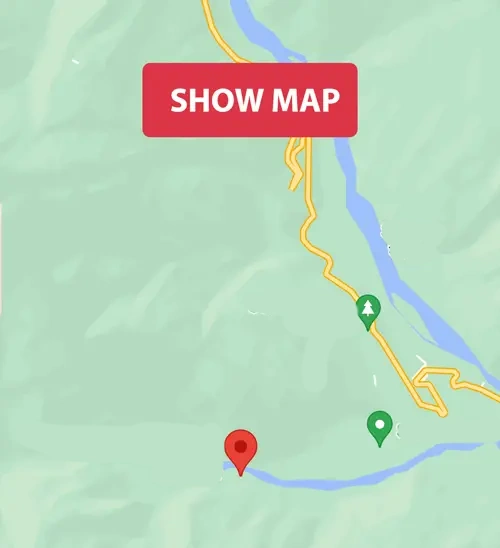
Why does Vithoba stand on brick?
Sant Pundalik was very much devoted to the service of his old parents. When Lord Krishna heard about him, he came to visit all the way from Dwaraka. Pundalik was busy. The Lord waited watching him in amusement standing on top of a brick. It is in memory of this that the idol of Vithoba has him standing on a brick.
What is the old name of Pandharpur?
According to a 618 CE inscription, Pandharpur was then known as Pandaraga.
Quiz
Which other God has a posture of hands on hips like Vithoba?Recommended for you
Do you know the importance of Omkara?
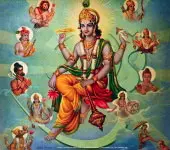 Click here to know more..
Click here to know more..
Garbha Rakshambika Stotram
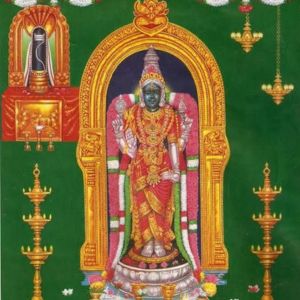
वापीतटे वामभागे वामदेवस्य देवी स्थिता वन्द्यमाना। vaapeetat'e ....
Click here to know more..Chidambaresha Stotram
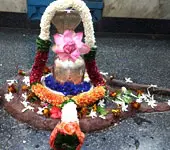
brahmamukhaamaravanditalingam janmajaraamaranaantakalingam. karmanivaaranakaushalalingam tanmri'du paatu chidambaralingam. kalpakamoolapratisht'hitali....
Click here to know more..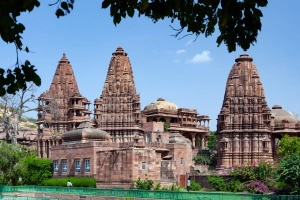
English Topics
Temples
Click on any topic to open
- 71 Ahobilam - Lord Narasimha's Sacred Abode
- 70 Malaikottai Temple, Trichy - Discover Spiritual Bliss
- 69 Jambukeswarar Temple, Trichy
- 68 Vaitheeswaran Koil - A Healing Pilgrimage
- 67 Dwaraka and Somnath
- 66 Khidkali Mahadev Mandir
- 65 Pongu Sani Temple, Thirukollikadu
- 64 The Unique And Fascinating Jharni Narasimhaswamy Temple, Bidar
- 63 Yamunotri: A Spiritual Haven in the Himalayas
- 62 Anantha Padmanabha Swamy Temple - Fascinating Legends
Please wait while the audio list loads..
30
Ganapathy
Shiva
Hanuman
Devi
Vishnu Sahasranama
Mahabharatam
Practical Wisdom
Yoga Vasishta
Vedas
Rituals
Rare Topics
Devi Mahatmyam
Glory of Venkatesha
Shani Mahatmya
Story of Sri Yantra
Rudram Explained
Atharva Sheersha
Sri Suktam
Kathopanishad
Ramayana
Mystique
Mantra Shastra
Bharat Matha
Bhagavatam
Astrology
Temples
Spiritual books
Purana Stories
Festivals
Sages and Saints
